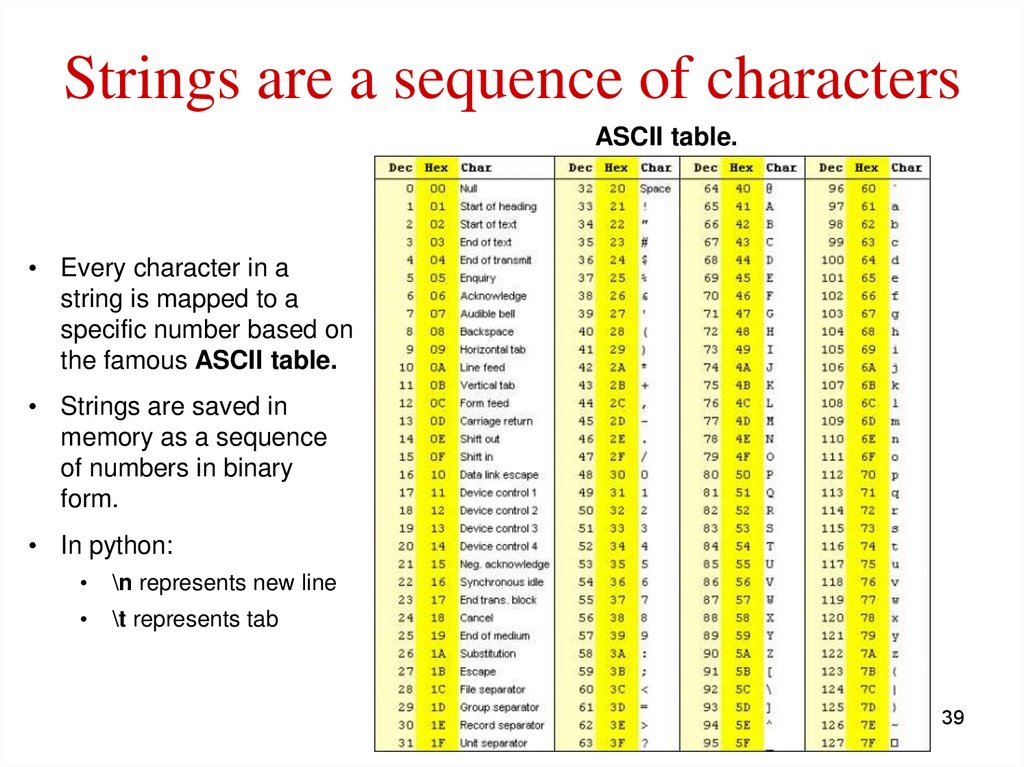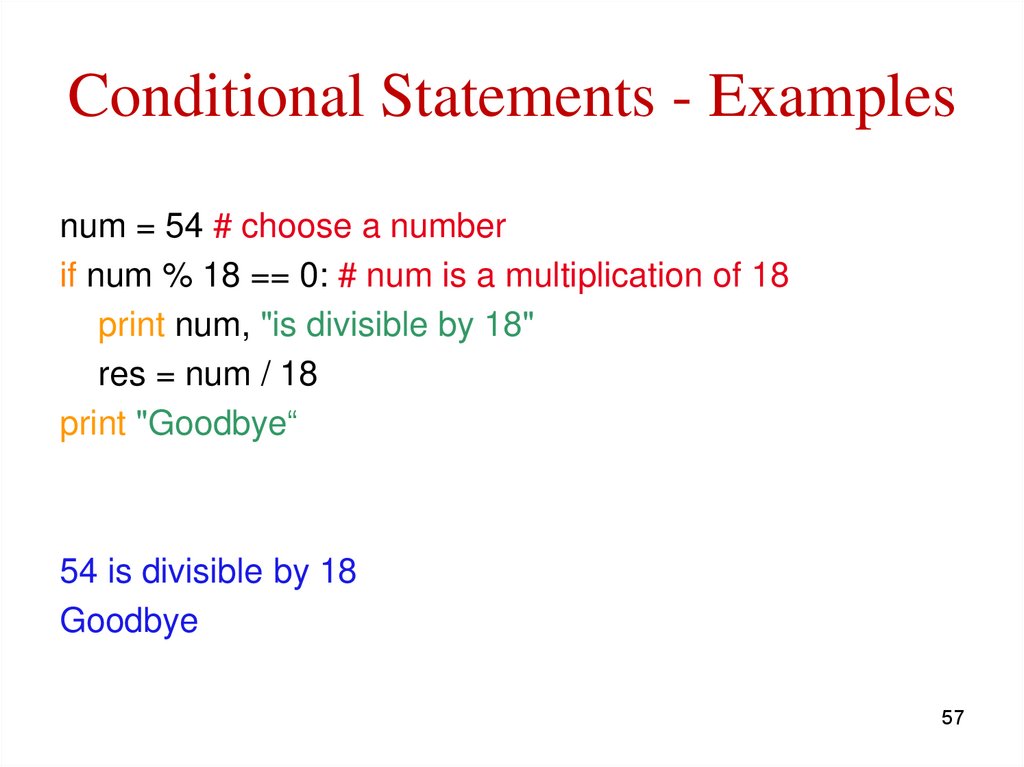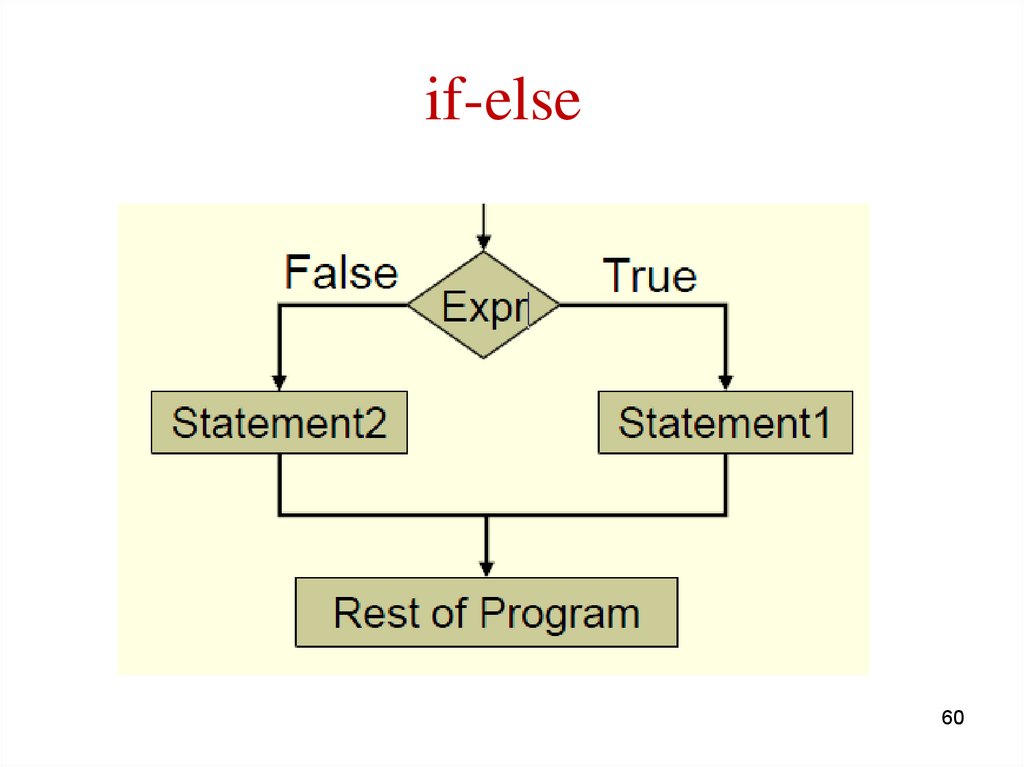Similar presentations:
Programming for Engineers in Python. Fall 2018
1.
Programmingfor Engineers
in Python
Fall 2018
Lecture 1: Introduction to Python
1
2.
Programming for Engineers in PythonWelcome to the course!
• We will learn to program in Python.
• Goal: enable you to use programming as a tool
for solving “real world” problems.
• Hard work is required!
2
3.
AdministrationLectures
Recitations
Guided Lab Instructor
Assignment graders
3
4.
Course websites1. Course website: http://www.cs.tau.ac.il/courses/pyProg/1819a/
• Course schedule
• Lecture and recitation presentations
• Code examples
• Assignments
• Homework guidelines
2. MOODLE website: http://moodle.tau.ac.il/course/view.php?id=509182099
• Homework submissions
• Forums (General + assignment specific)
4
5.
Recitations• Practical Sessions
• In a standard classroom
• Purposes:
• Practice topics presented in class.
• Preparations for next class.
• Background for homework assignments.
• Learn practical tools.
• Lectures are usually harder to understand, and it is
OK.
5
6.
Guided Lab• Optional practical session in a computer lab
• Technical support (IDLE, Python files, etc.)
6
7.
Homework• Let’s read the guidelines on the course website
7
8.
A Personal Note on HWIt will take you a lot of
time and effort to
make the code work.
But
There is no other
way to learn how to
program
8
9.
Working Environment• Lab 008
• Home versus lab
VS.
9
10.
The Exam• Final grade is composed out of homework and final
exam
• You must pass the exam to pass the course
• Written exam
• Includes all course material:
• Lectures, recitations, and HW
10
11.
Course ObjectivesDevelop basic programming
and algorithmic skills
!
Remember: we learn programming, not
how computer hardware works
11
12.
SyllabusPython programming basics • Data analysis
File I/O
• Scientific Calculations
using NumPy
Error Handling
• Image Processing
Recursion
Sort & Search algorithms
Object-Oriented
Programming
12
13.
Resources• Course slides and pointers to relevant bibliography.
• Recommended resources:
• Book: Think Python, by Allen B. Downey
(http://greenteapress.com/thinkpython/thinkpython.html)
• Manual: Python 2.x documentation http://docs.python.org//
(the official language manual)
13
14.
Questions?14
15.
Preface• We assume no prior knowledge.
• However, we advance fast.
• The only way to keep on track is to practice!
15
16.
Today• Brief background to programming
• Python basics:
• Variables
• Numbers
• Strings
• Arithmetic Operators
• Comparison Operators
• Logical Operators
• Branching (if)
16
17.
Programming Languages Basics• A computer program is a sequence of text instructions
that can be “understood" by a computer and executed.
• A programming language is a machine-readable
artificial language designed to express computations
that can be performed by a computer.
Over 500 different
computer languages
are listed by
Wikipedia
17
18.
Machine Code (Language)Computers understand only machine language.
Basically looks like a sequence of 1’s and 0’s.
Very inconvenient to work with and non-intuitive.
All
other computer languages were created for human
convenience.
The computer does not understand C/Python/Java They must be “translated” into machine language
In this course, we do not care how the computer does that
18
19.
Computer Program• A sequence of instructions designed to achieve a
specific purpose
• The instructions are executed sequentially. No
instruction is executed before the previous is completed
19
20.
Language Selection and PythonPython (since 1991):
Quick development
Easy to learn
Huge community
Short development-execution rounds
Fast enough for most applications
Cross-platform
Guido van Rossum
20
21.
Python is Good for Your Future..Python is widely industrial used (Google, Yahoo!,
YouTube, BitTorrent, IDF, NASA)
Take a look at Python's community conference
• Short development-execution rounds
• Huge community
• Fast enough for most applications
• Cross-platform
21
22.
Installing and Running Python 2.7• Python 2.7 is already installed in the computers’ lab.
• Install Anaconda distribution for Python 2.7 from here:
http://continuum.io/downloads
• Available for window, Max OS and Linux
• The Anaconda package includes:
• Python’s interpreter required for running Python programs
• Python editors for writing Python programs (i.e. IDLE, Spyder)
• Many useful Python extension packages (i.e. Numpy, Scipy)
• We do not use Python 3!
• Regular python installation available here:
http://python.org/download/
This installation is not recommended since it does not contain all the models
22
we are using in this course.
23.
Using Anaconda• Run idle.exe to open the Idle terminal.
• The executable file is located in
INSTALL_DIR\Anaconda\Scripts (INSTALL_DIR stands for
the installation directory, usually C:\ or C:\Program Files)
• It is recommended to create a shortcut on your desktop.
This is how idle shell looks like:
A video on working with IDLE:
http://www.youtube.com/watch?v=lBkcDFRA958
23
24.
Hello World!24
25.
My First Python Program:Hello World!
Separate commands typed in Python’s shell are executed by
Python’s interpreter, and the output is printed to the screen.
For longer programs, we will assemble several commands into a
script (program), and save it to a *.py file which can be executed.
25
26.
Computer’s Memory• The computer memory is composed of a long
list of bits. Each bit can hold a value of either
0 or 1.
• Bits are grouped into Bytes (8 bits).
• 1 Byte can hold 256 different values (28 ).
• Every Byte is numbered sequentially. The
byte’s index is called its memory address.
26
27.
Using variables to store data inmemory
• Computer programs manipulate data.
• Data is given either as input, or calculated by
the program.
• To access it later, data must be remembered.
• Therefore, computer programs use variables to
store data in the memory.
“Bob”
True
35
• Each variable has…
– A value (content, the stored data)
– A name (a shortcut to its address in memory)
– A type (str, int, float, bool)
s
r
age
str
bool
int
27
28.
Program variables• Each variable has: Name, Value, Type (and an
Address of the location in memory where its value
is stored).
• The variable’s value is encoded as a binary number
which is stored in one or more bytes in the
computer’s memory.
“Bob”
True
35
s
r
age
str
bool
int
• In Python we create variables simply by assigning a
value to a variable name:
s = “Bob”
r = True
age = 35
-
The variable’s type is automatically determined in
Python based on its assigned values and actions (“duck
typing”)
28
29.
Data Types in PythonCommonly used built in data types:
• Numeric types: int, float, long, complex
• Boolean: bool
• String: str
Why Do We Need Different Types?
• Saving memory
• Execution speed
• Different actions
b
True
29
30.
Hands On30
31.
The ‘type’ command returns thetype of a variable/expression
>>> 4
4
>>> type(4)
<class 'int'>
>>> 3.14159
3.14159
>>> type(3.14159)
<class 'float'>
An integer number
A real number (floating point)
31
32.
Variables and Assignments>>> n = 10
>>> m = (10 + 4) * 5
Left-hand side is a variable.
Right-hand side is an expression.
The interpreter:
n
m
10
70
1. Evaluates the expression
2. Assigns its value to the variable.
Variable's name - a sequence of letters and digits,
starting with a letter.
32
33.
Variables and Assignments:An Example
Changing the value of a variable:
>>> n = 11
>>> n
11
Changing the type of a variable:
>>> n = 1.3141
>>> n
1.3141
Variables can be used in expressions:
>>> pi = 3.14159
>>> pi * 2 + 1
7.28318
33
34.
Variables and Assignments – Cont.Referring to undefined variables leads to runtime error
>>> check_this
Traceback (most recent call last):
File "<pyshell#16>", line 1, in <module>
check_this
NameError: name 'check_this' is not defined
34
35.
Arithmetic OperatorsOperator
Use
Description
+
x+y
Sum of x and y
-
x-y
Subtracts y from x
*
x*y
Multiplies x by y
**
x ** y
x to the power y
/
x/y
Divides x by y
%
x%y
Modulu: the remainder of dividing x by y
What’s the type of 8/5 ? And of 8/5.0 ?
The result of int/int is an int !
35
36.
Playing with Variables>>> a = 3
>>> a
3
>>> b = 5
>>> b
5
>>> c = a + b
>>> c
8
>>> c = c * 2
>>> c
16
>>> first = (a + b) * 2
>>> second = a + b * 2
>>> first, second
(16, 13)
>>> a, b
(3, 5)
>>> b / a
1
>>> b % a
2
>>> b**a
125
36
37.
Strings• String variables are used to save text.
• An ordered sequence of characters.
37
38.
String Access>>> a = 'Hello'
>>> a[1]
'e'
>>> a[1:3]
'el'
>>> a[1:]
'ello'
>>> a[-4:-2]
'el'
>>> a[:-3]
'He'
>>> a[-3:]
'llo’
H
e
l
l
o
0
1
2
3
4
-5
-4
-3
-2
-1
5
38
39.
Strings are a sequence of charactersASCII table.
• Every character in a
string is mapped to a
specific number based on
the famous ASCII table.
• Strings are saved in
memory as a sequence
of numbers in binary
form.
• In python:
\n represents new line
\t represents tab
39
40.
String Type40
41.
Strings concatenation>>> s1 = "He"
>>> s2 = "llo"
>>> s3 = s1 + s2
>>> s3
'Hello'
>>> s4 = s3 + " World"
>>> c = "!"
>>> print s4, 2015, c
Hello World 2015 !
41
42.
Strings Indices42
43.
Strings are ImmutableYou cannot mutate
(change) existing
strings. Only create
new ones !
>>> a = "abc"
>>> a[0] = 'a'
Traceback (most recent call last):
File "<pyshell#21>", line 1, in <module>
a[0]='a'
TypeError: 'str' object does not support item assignment
However, pointing to another string is valid:
>>> a = "abc"
Immutable variables cannot be changed after created.
Applying operations on immutable variables usually return
>>> a = "ggg"
a new variable rather changing the original variable
43
44.
Special characters and string operatorshttp://www.tutorialspoint.com/python/python_strings.htm
• Special characters: \n (new line) \t (tab)
• Special string operators:
a = 'Hello', b = 'Python'
Operator
+
*
][
]:[
in
not in
%
Description
Concatenation - Adds values on either side of the
operator
Repetition - Creates new strings, concatenating
multiple copies of the same string
Slice - Gives the character from the given index
Range Slice - Gives the characters from the given
range
Membership - Returns true if a character exists in
the given string
Membership - Returns true if a character does not
exist in the given string
Format - Performs String formatting
Example
a + b will give
'HelloPython'
a*2 will give
'HelloHello'
a[1] will give 'e'
a[1:4] will give 'ell'
'H' in a will give True
'M' not in a will give
True
See at next section
44
45.
Strings - Built In Methodshttp://docs.python.org/release/2.5.2/lib/string-methods.html
The str type in Python includes many built-in commands for working with Strings
45
46.
Strings - Built In Methodshttp://www.tutorialspoint.com/python/python_strings.htm
• String Formatting Operator
>>> print "My name is %s and my age is %d !" % ('Zara', 21)
My name is Zara and my age is 21 !
• Useful String methods:
–
–
–
–
–
–
len
find, startswith, endswith
isalpha, isdigit, islower,…
join, replace
strip, rstrip
split
46
47.
Type ConversionConvert variable type using int(), str() and float()
>>> num = 123
>>> num
123
>>> num_str = str(num)
>>> num_str
'123'
>>> int(2.5)
2
47
48.
Comparison OperatorsCompares two variables and returns a Boolean
type result/variable
Operator
Name
Description
x<y
Less than
true if x is less than y, otherwise false.
x>y
Greater than
true if x is greater than y, otherwise false.
x <= y
Less than or equal
to
true if x is less than or equal to y, otherwise
false.
x >= y
Greater than or
equal to
true if x is greater than or equal to y,
otherwise false.
x == y
Equal
true if x equals y, otherwise false.
x != y
Not Equal
true if x is not equal to y, otherwise false.
48
49.
Comparison Operators>>> 5.0 == 5
True
>>> 6 != 2*3
False
>>> -2 >= 1
False
>>> 3 <= 3
True
>>> x = 3 < 3
>>> x
False
>>> type(x)
<type 'bool'>
49
50.
Comparison Operators>>> 'a' != 'b'
True
>>> 'a' < 'b'
True
50
51.
Logical OperatorsOperate on two Booleans and return Booleans
Operator
Description
Both True: True,
otherwise: False.
At least one is rue: True,
y
Otherwise: False.
x and y
x or
not
x x is False True, x is True False
51
52.
And, or, notor
and
0
1
0
0
0
1
0
1
0
1
0
0
1
not
1
1
1
0
1
1
0
52
53.
Logical Operators>>> a = True
>>> b = True
>>> c = False
>>> d = False
>>> a and b
True
>>> a and c
False
>>> a or c
True
>>> not a
False
53
54.
Flow ControlDifferent inputs Different execution order
– Computer games
– Illegal input
Control structures
– if-else
– for loop
– while loop
http://xkcd.com/1195/
54
55.
Conditional Statement: ifUsed to execute statements conditionally
Syntax
Condition = expression that evaluates to a Boolean
if condition:
Indentation = determines the scope of the if block
statement1
statement2
…
• If condition is True, statements are executed
55
56.
Conditional Statements56
57.
Conditional Statements - Examplesnum = 54 # choose a number
if num % 18 == 0: # num is a multiplication of 18
print num, "is divisible by 18"
res = num / 18
print "Goodbye“
54 is divisible by 18
Goodbye
57
58.
Conditional StatementsIndentation:
• Following the if statement:
Open a new scope = one tab to the right.
• Indicates the commands within the scope
of this if.
58
59.
if-elseif condition1:
statement1
else:
statement2
rest of code
condition1 is true execute statement1
condition1 is false execute statement2
execute rest of code
59
60.
if-else60
61.
if-elseif width == height:
print "found a square"
else:
print "found a rectangle"
width = height
print "now it is a square"
Indentation:
else is not a part of the if scope!
The commands under else are indented.
61
62.
if-elsea=4
b=5
c=6
if a + b > c and a + c > b and b + c > a:
print "Building a triangle"
else:
print "Cannot build a triangle"
62
63.
if-elif-elseif condition1:
statement1
elif condition2:
statement2
else:
statement3
elif = if-else
rest of code
condition1 is true execute statement1
condition1 false and condition2 true execute statement2
condition1 and condition2 are false execute statement3
execute rest of code
63
64.
if-elif-elseif price < 100:
print "too cheap"
elif price > 200:
print "too expensive“
else:
print "reasonable price"
64
































































 programming
programming








